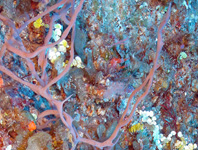Abstract
Hamacantha occurs worldwide and frequently in deep-waters. It is easily distinguished from any other sponge by the possession of conspicuous diancistra microscleres. Here we describe two new species from the Rio Grande Rise. Hamacantha (Vomerula) jeanvaceleti sp. nov. is the sole Hamacantha with styles, diancistras in two categories with the smaller ones cyrtancistra-like; and H. (V.) klausruetzleri sp. nov., the sole with two types of megascleres (styles and strongyles), two categories of diancistras, and two categories of sigmas.
References
Bowerbank, J.S. (1864) A Monograph of the British Spongiadae. Vol. 1. Ray Society, London, xx + 290 pp., XXXVII pls.
https://doi.org/10.5962/bhl.title.2038Bowerbank, J.S. (1874) A Monograph of the British Spongiadae. Vol. 3. Ray Society, London, xvii + 367 pp., XCII pls.
Grant, R.E. (1836) Animal Kingdom. In: Todd, R.B. (Ed.), The Cyclopaedia of Anatomy and Physiology. Vol. 1. Sherwood, Gilbert, and Piper, London, pp. 107–118.
Gray, J.E. (1867) Notes on the Arrangement of Sponges, with the Descriptions of some New Genera. Proceedings of the Zoological Society of London, 1867 (2), 492–558, pls. XXVII–XXVIII.
Hajdu, E. (1994) A phylogenetic interpretation of hamacanthids (Demospongiae, Porifera), with the redescription of Hamacantha popana. Journal of Zoology, 232, 61–77.
https://doi.org/10.1111/j.1469-7998.1994.tb01559.xHajdu, E. & Castello-Branco, C. (2014) Hamacantha (Hamacantha) boomerang sp. nov. from deep-sea coral mounds at Campos Basin, SW Atlantic, and redescription of H. (H.) schmidtii (Carter, 1882) (Hamacanthidae, Poecilosclerida, Demospongiae). Zootaxa, 3753 (4), 384–390.
https://doi.org/10.11646/zootaxa.3753.4.7Hajdu, E., Castello-Branco, C., Lopes, D.A., Sumida, P.Y.G. & Perez, J.A.A. (2017) Deep-sea dives reveal an unexpected hexactinellid sponge garden on the Rio Grande Rise (SW Atlantic). A mimicking habitat? Deep-Sea Research Part II: Topical Studies in Oceanography, 146, 93–100.
https://doi.org/10.1016/j.dsr2.2017.11.009Hajdu, E., Hooker, Y., Willenz, P. (2015) New Hamacantha from Peru and resurrection of Zygherpe as subgenus (Demospongiae, Poecilosclerida, Hamacanthidae). Zootaxa. 3926 (1), 87–99.
https://doi.org/10.11646/zootaxa.3926.1.3Hajdu, E., Peixinho, S. & Fernandez, J.C.C. (2011) Esponjas Marinhas da Bahia—Guia de Campo e Laboratório. Série Livros 45. Museu Nacional/UFRJ, Rio de Janeiro, 276 pp.
Hestetun, J.T., Vacelet, J., Boury-Esnault, N., Borchiellini, C., Kelly, M., Ríos P., Cristobo, J. & Rapp, H.T. (2016) The systematics of carnivorous sponges. Molecular Phylogenetics and Evolution, 94, 327–345.
https://doi.org/10.1016/j.ympev.2015.08.022Lévi, C. (1993) Porifera Demospongiae: Spongiaires bathyaux de Nouvelle-Calédonie, récoltés par le ‘Jean Charcot’. Campagne BIOCAL,1985. In: Crosnier, A. (Ed.), Résultats des campagnes MUSORSTOM. Vol. 11. Mémoires du Muséum national d’Histoire naturelle, A, Zoologie, 158, pp. 9–87.
Lopes, D.A. & Hajdu, E. (2004) Two new Mycalina from the south-eastern Brazilian shelf and slope collected by Programme REVIZEE (Poecilosclerida: Demospongiae). Journal of the Marine Biological Association of the United Kingdom, 84 (1), 25–28.
https://doi.org/10.1017/S0025315404008860hLundbeck, W. (1902) Porifera. (Part I.) Homorrhaphidae and Heterorrhaphidae. In: The Danish Ingolf-Expedition. 6 (1). Bianco Luno, Copenhagen, pp. 1–108, pls. I–XIX, 1 map.
Morrow, C. & Cárdenas, P. (2015) Proposal for a revised classification of the Demospongiae (Porifera). Frontiers in Zoology, 12, 7.
https://doi.org/10.1186/s12983-015-0099-8Pulitzer-Finali, G. (1977–1978) Report on a Collection of Sponges from the Bay of Naples. III Hadromerida, Axinellida, Poecilosclerida, Halichondrida, Haplosclerida. Bollettino dei Musei e degli Istituti Biologici della (R.) Università di Genova, 45, 7–89.
Redmond, N.E., Morrow, C.C., Thacker, R.W., Diaz, M.D., Boury-Esnault, N., Cardenas, P., Hajdu, E., Lobo-Hajdu, G., Picton, B.E., Pomponi, S.A., Kayal, E. & Collins, A.G. (2013) Phylogeny and Systematics of Demospongiae in Light of New Small-Subunit Ribosomal DNA (18S) Sequences. Integrative & Comparative Biology, 53, 388–415.
https://doi.org/10.1093/icb/ict078Ridley, S.O. & Dendy, A. (1886) Preliminary Report on the Monaxonida collected by H.M.S. ‘Challenger’. Annals and Magazine of Natural History, Series 5, 18, 325–351, 470–493.
https://doi.org/10.1080/00222938609459998Schmidt, O. (1880) Die Spongien des Meerbusen von Mexico (Und des caraibischen Meeres). Heft II. Abtheilung II. Hexactinelliden. Abtheilung III. Tetractinelliden. Monactinelliden und Anhang. Nachträge zu Abtheilung I (Lithistiden). In: Reports on the dredging under the supervision of Alexander Agassiz, in the Gulf of Mexico, by the USCSS ‘Blake’. Gustav Fischer, Jena, pp. 33–90, pls. V–X.
Sollas, W.J. (1885) A Classification of the Sponges. Annals and Magazine of Natural History, Series 5, 16 (95), 395.
https://doi.org/10.1080/00222938509459901Topsent, E. (1896) Campagnes du Yacht Princesse Alice. Sur deux curieuses Espérellines des Açores. Bulletin de la Société Zoologique de France, 21, 147–150.
Topsent, E. (1904) Spongiaires des Açores. Résultats des campagnes scientifiques accomplies par le Prince Albert I, Monaco, 25, 1–280, pls. 1–18.
https://doi.org/10.5962/bhl.title.61852Topsent, E. (1909) Etude sur quelques Cladorhiza et sur Euchelipluma pristina n. g. et n. sp. Bulletin de l’Institut océanographique, Monaco, 151, 1–23, pls. I–II.
Topsent, E. (1920) Spongiaires du Musée Zoologique de Strasbourg. Monaxonides. Bulletin de l’Institut océanographique, Monaco, 381, 1–36.
Topsent, E. (1928) Spongiaires de l’Atlantique et de la Méditerranée provenant des croisières du Prince Albert ler de Monaco. Résultats des campagnes scientifiques accomplies par le Prince Albert I. Monaco, 74, 1–376, pls. I–XI.
Vacelet, J. (1979) Descriptions et affinités d'une éponge sphinctozoaire actuelle. In: Lévi, C. & Boury-Esnault, N. (Eds.), Biologie des Spongiaires. Sponge Biology. Colloques Internationaux du Centre National de la Recherché Scientifique, Paris, 291, pp. 483–493.
Van Soest, R.W.M. (1984) Marine sponges from Curaçao and other Caribbean localities. Part III. Poecilosclerida. In: Hummelinck, P.W. & Van der Steen, L.J. (Eds.), Uitgaven van de Natuurwetenschappelijke Studiekring voor Suriname en de Nederlandse Antillen. No. 112. Studies on the Fauna of Curaçao and other Caribbean Islands, 66 (199), pp. 1–167.

